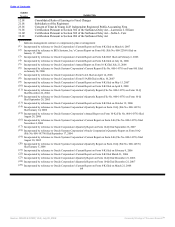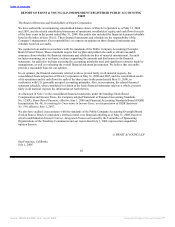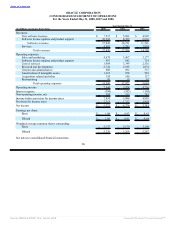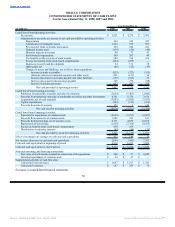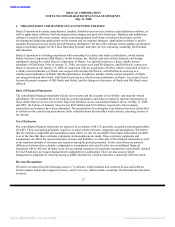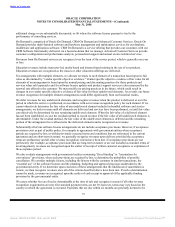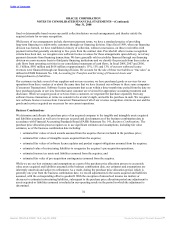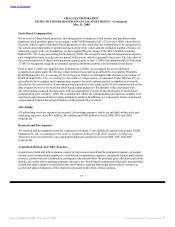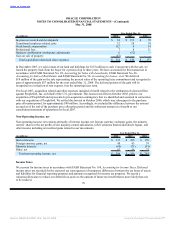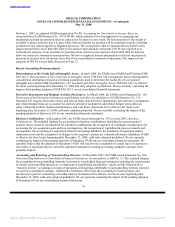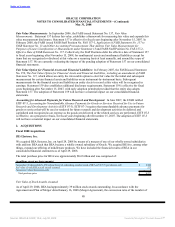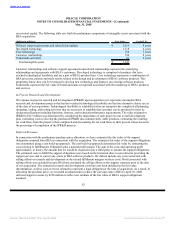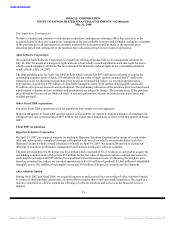Oracle 2007 Annual Report Download - page 79
Download and view the complete annual report
Please find page 79 of the 2007 Oracle annual report below. You can navigate through the pages in the report by either clicking on the pages listed below, or by using the keyword search tool below to find specific information within the annual report.
Table of Contents
ORACLE CORPORATION
NOTES TO CONSOLIDATED FINANCIAL STATEMENTS—(Continued)
May 31, 2008
fixed or determinable based on our successful collection history on such arrangements, and thereby satisfy the
required criteria for revenue recognition.
While most of our arrangements include short-term payment terms, we have a standard practice of providing
long-term financing to creditworthy customers through our financing division. Since fiscal 1989, when our financing
division was formed, we have established a history of collection, without concessions, on these receivables with
payment terms that generally extend up to five years from the contract date. Provided all other revenue recognition
criteria have been met, we recognize new software license revenues for these arrangements upon delivery, net of any
payment discounts from financing transactions. We have generally sold receivables financed through our financing
division on a non-recourse basis to third party financing institutions and we classify the proceeds from these sales as
cash flows from operating activities in our consolidated statements of cash flows. In fiscal 2008, 2007 and 2006,
$1.1 billion, $891 million and $618 million or approximately 15%, 15% and 13% of our new software license
revenues were financed through our financing division. We account for the sale of these receivables as “true sales” as
defined in FASB Statement No. 140, Accounting for Transfers and Servicing of Financial Assets and
Extinguishments of Liabilities.
Our customers include several of our suppliers and on rare occasion, we have purchased goods or services for our
operations from these vendors at or about the same time that we have licensed our software to these same companies
(Concurrent Transactions). Software license agreements that occur within a three-month time period from the date we
have purchased goods or services from that same customer are reviewed for appropriate accounting treatment and
disclosure. When we acquire goods or services from a customer, we negotiate the purchase separately from any
software license transaction, at terms we consider to be at arm’s length, and settle the purchase in cash. We recognize
new software license revenues from Concurrent Transactions if all of our revenue recognition criteria are met and the
goods and services acquired are necessary for our current operations.
Business Combinations
We determine and allocate the purchase price of an acquired company to the tangible and intangible assets acquired
and liabilities assumed as well as to in-process research and development as of the business combination date in
accordance with Financial Accounting Standards Board (FASB) Statement No. 141, Business Combinations. The
purchase price allocation process requires us to use significant estimates and assumptions, including fair value
estimates, as of the business combination date including:
• estimated fair values of stock awards assumed from the acquiree that are included in the purchase price;
• estimated fair values of intangible assets acquired from the acquiree;
• estimated fair values of software license updates and product support obligations assumed from the acquiree;
• estimated value of restructuring liabilities to reorganize the acquiree’s pre-acquisition operations;
• estimated income tax assets and liabilities assumed from the acquiree; and
• estimated fair value of pre-acquisition contingencies assumed from the acquiree.
While we use our best estimates and assumptions as a part of the purchase price allocation process to accurately
value assets acquired and liabilities assumed at the business combination date, our estimates and assumptions are
inherently uncertain and subject to refinement. As a result, during the purchase price allocation period, which is
generally one year from the business combination date, we record adjustments to the assets acquired and liabilities
assumed, with the corresponding offset to goodwill. With the exception of unresolved income tax matters or
decreases to estimated restructuring liabilities, subsequent to the purchase price allocation period any adjustment to
assets acquired or liabilities assumed is included in our operating results in the period in which the adjustment is
determined.
74
Source: ORACLE CORP, 10-K, July 02, 2008 Powered by Morningstar® Document Research℠


